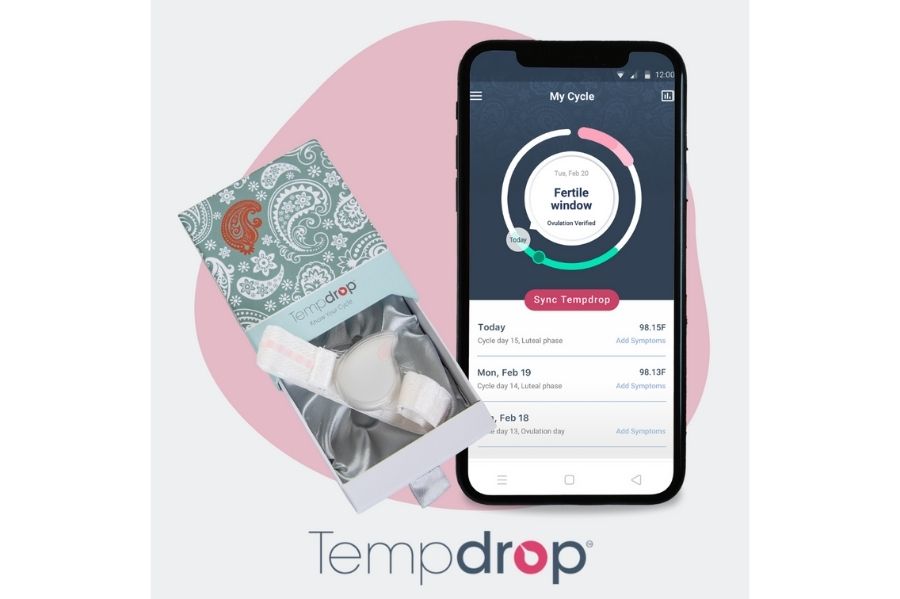Over the years, we’ve seen the empowerment that comes with charting your cycle. It enables you to advocate for your own health and puts you in control of your fertility choices. The practice of charting can be grounding; it can bring clarity and help you to feel in control, especially when you are trying to conceive.

Written by Guest Blogger: Tempdrop Team
Charting can help you:
- identify the optimal time for conception,
- confirm your body is ovulating
- and give you insights into your hormone health so you can prepare for your pregnancy.
For conception to occur, we need several key things:
- Cervical mucus – this is essential to keep sperm alive and nourished (it can keep sperm alive for up to 5 days) so that sperm can reach the egg.
- A viable egg needs to be released.
- Healthy sperm need to reach the egg.
- There needs to be enough time after ovulation and a suitable environment for the fertilized egg to implant.
By tracking your fertility biomarkers, such as your basal body temperature and cervical mucus you can confirm if and when ovulation is taking place. Because the egg only lives for 12-24 hours, and sperm can only stay alive for five days, there is only a brief window each cycle that conception can occur and you want to maximize your chances during this small window of time.
Being able to pinpoint ovulation maximizes your chances of conception.
You might be wondering HOW you can track these key fertility signs. Firstly let’s understand what each of them are:
Basal Body Temperature (BBT) is the temperature of your body at rest, or during sleep. Body temperature is influenced by the cyclic ebb and flow of hormones in women. There is a noticeable difference in the pattern of their temperatures before and after ovulation.
Cervical Mucus or Cervical Fluid (CM) is a bodily fluid produced by the cervix. As we mentioned earlier it’s essential to keep sperm alive. Over the course of the cycle, CM changes in both quality and quantity and it indicates when ovulation is approaching.
Tracking these symptoms can seem daunting at first, but Tempdrop makes this process simple with their all-in-one solution – a wearable sensor to capture your BBT (so you can avoid those early morning set wake ups) and a charting app with fertility predictions to help you identify the optimal time for conception and get pregnant sooner.

“Another tempdrop pregnancy! I got pregnant on my second cycle using tempdrop. I was unsure about my ovulation date for the cycle I conceived. But, based on my dating ultrasound last week, Tempdrop got my ovulation date exactly right.” – Tempdrop customer
Beyond helping you time conception and maximize your chances of pregnancy, fertility charting can also help you troubleshoot potential fertility challenges. Charting gives you real-time health data. This information is vital when you seek treatment for fertility issues.
Your fertility chart gives you essential data that can be used in conjunction with other tests. Since your hormone levels change from day to day and hour to hour, some lab tests can only reveal so much. In addition, some doctors will have different lab ranges for what is considered “normal.” Whereas, a chart can give your practitioner insights and help them to diagnose any potential reproductive health issues, such as PCOS or a thyroid imbalance.
As a result, you can spend less time guessing and treating the root cause of the problem.

About Tempdrop – Tempdrop is passionate about women’s health; and menstrual cycle tracking is one key factor in really knowing your body. Tempdrop is a wearable basal body temperature sensor and charting app. The sensor is worn during sleep and combines smart sensors and algorithms to accurately measure and track sleeping temperature and data. The sensor is integrated with a charting app to deliver a complete solution. Its data offers an important piece to the fertility puzzle and can help women maximize their chances of pregnancy.
Guest Blogger,
Tempdrop Team
P.S. Catch next week’s episode of The Hormone P.U.Z.Z.L.E Podcast featuring Tempdrop’s Melony Angus (FAE).
You can also find the episode on this podcast page as well as Spotify, and Stitcher.
Don’t forget to subscribe, follow, and write us a review on Apple Podcast (if you LOVE it).

